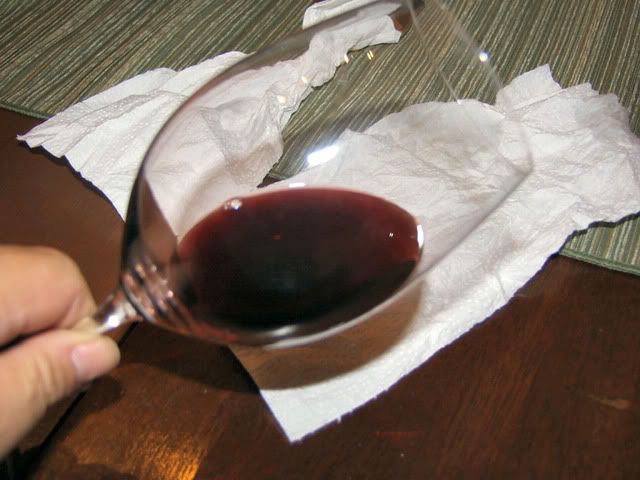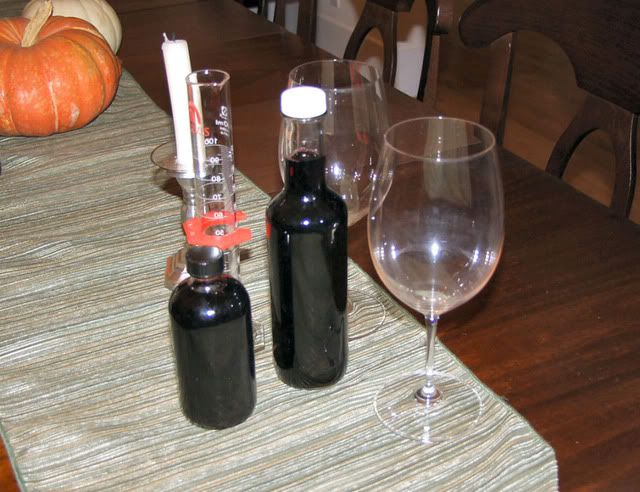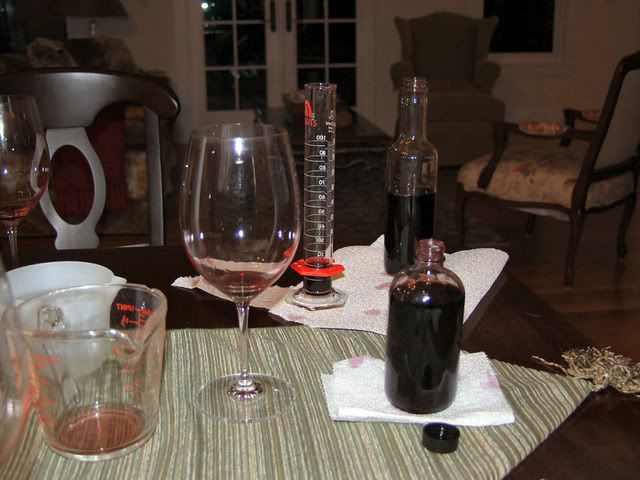Hopefully you can see that the color has a warmth to it that is not as desirable as could be. To be sure, I have had some wonderful tasting wine that the color was off. In fact, in my own beer brewing, I have had some brews that tasted incredible, but, the color was not true to style. This wine represents the same paradox. But, we have a cure.
In fact there are a couple of cures to this problem. One more of a 'good living through science' process and one that is centuries old. Mega-purple is an additive used in the wine industry that is essentially a concentrated grape juice derivative that can be used to adjust the color of a wine. Since it is a 'natural' grape product, it is not required to be included in the labeling of wine. The rumors are that many wines, even some very highly priced and rated wines use a touch or two of this product to correct color. We chose the more traditional method of using a blending wine to adjust the color. In this photo, you can see the Cabernet in the white capped bottle and the blending wine, a Petite verdot in the black capped bottle.
Here was the start of our blending session, there were three of us, one of the glasses had gone missing prior to my hitting the shutter. As you can see, there is a graduated cylinder, the classic candle (for looks really) and some Reidel glasses. We also had notepads, a calculator and a dropper to measure out small amounts of the blending wine. The really surprising thing is how much of an effect the Petite verdot had on the Cabernet base wine.
First we tested the base wine alone, it definitely showed the characteristics of a Napa Valley cabernet, this one showing extremely well integrated tannins, smooth black fruit and minerality along with a decent nose. We are working with a wine from just below the Howell Mountain AVA, so this is somewhat off-style from what we were looking for. The Petite verdot was not impressive on any account, it was extremely subdued in all aspects and certainly not a wine I would drink.
Upon blending to create a 99% CS-1% PV wine, we found that not only was the color greatly improved, but, the nose and tannins we more pronounced. A 1% solution seemed so minute, yet the effect of the Petite verdot was quite noticeable. Further blends of 3%, 5% and 6% produced even more profound improvements in the base wine. Here is what dining room blending looks like...
Nothing quite like blending red wines on someone else's holiday table runner. In the end, as big fans of Napa Cabernet sauvignon and big wines in general, we selected the higher concentration of 5%, as this offered a really nice dark ruby color to the wine, with pronounced tannins and fruit. The blending of the Petite verdot really affected the overall appearance, but even more so, enhanced and defined the flavors of the base Cabernet wine. Of course, the final verdict of this decision will not be known for over a year, as the blend ages in barrel. After this, it was off to get some dinner.




No comments:
Post a Comment